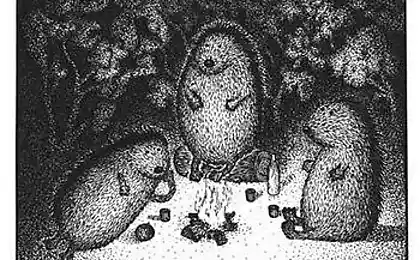816
HoС

Everyone knew about the nose of the monk Zenti in Ikenoo. This nose was five or six suns long and dangled through the lip below the chin, and its thickness, which at the base, that at the tip, was exactly the same. There was a long thing in his face that looked like a sausage.
The monk was over fifty, and all his life, from the ancient times of tonsure to the present day, already awarded the high rank of naidojogubu[1], he grieved bitterly because of this nose. Of course, even now he pretended that the object bothered him very little. And it was not only that tormented about the nose he considered unsuitable for the priest, who should give all his thoughts to the future existence near the Buddha Amida[2]. He was much more troubled, lest one guessed how much his own nose annoyed him. During everyday conversations, he was most afraid that the conversation would turn to noses.
The monk's nose was heavy for two reasons.
First, the long nose caused everyday inconvenience. For example, the monk could not eat on his own. If he ate unaided, the tip of his nose would sink into a cup of food. Therefore, during the meal, the monk had to sit at a table opposite him one of the disciples, so that he supported the nose with a special tablet wide and two shaka long. Eating food in this way was always difficult for both the student and the teacher. Once, instead of a student, a boy-obedient held his nose. In the middle of the meal, he sneezed, his hand with a tablet trembled, and his nose fell into rice porridge. The rumor about this incident reached the capital at one time. And yet this was not the main reason why the monk grieved over his nose. He really suffered from a broken heart.
The inhabitants of Ikeno said that the monk with his nose was lucky that he was a monk and not a layman, because, in their opinion, there would be hardly a woman who would agree to marry him. Some critics even claimed that he cut his hair because of his nose. However, the monk himself did not at all imagine that his belonging to the spiritual class at all alleviated the suffering caused by his nose. His pride was deeply affected by considerations such as the question of marriage. So he tried to heal the wounds of his pride by both active and passive means.
First, the monk was looking for a way to make his nose seem shorter than it actually was. When no one was around, he struggled, looking at his face from all sorts of angles. No matter how he changed his head, he did not become calmer, and he persistently looked at his reflection, then propping his cheek with his palm, then putting his fingers to his chin. But he never saw his nose short enough to comfort him. And the more bitter his heart became, the longer his nose seemed. Then the monk put the mirror in the box, sighed harder than usual and reluctantly returned to his former place to the Pepitre to read the sutra "Cannon-kyo"[3].
The monk was always very concerned about other people's noses. The Ikeno Temple was one of those temples where initiation ceremonies, sermons and so on are often held. The entire interior of the temple was densely built up with cells, water was heated every day in the temple baths. Visitors – monks and laity – was unusually large. The monk looked tirelessly at the faces of these people. He hoped to find one person with the same nose as his, so he would feel better. Therefore, his eyes did not notice either blue jackets or white kimonos, and the brown hats of the laity and the gray clothes of the clergy were so familiar to him that they did not exist for him. The monk did not see people, he only saw noses. But the noses were hooked at best, the same noses as his, he had not seen. And every day the monk fell more and more in spirit. In conversing with someone, he unconsciously caught the tip of his dangling nose with his fingers, always blushing, just like a child caught in a prank, which circumstance fully followed from this bad state of mind.
Finally, for some comfort, the monk sought out characters with noses like his in Buddhist and secular books. However, none of the scriptures stated that either Mangalayan or Shariputra had long noses.[4] Nagarjuna[5] and Aswaghosha[6] were also, of course, saints with ordinary noses. Once, in a conversation about China, a monk heard that the Shuhan prince Liu Xuande[7] had long ears, and he thought how much less lonely he would feel if it was a nose.
Needless to say, the monk, scratching his head over passive means, also tried active methods of influencing his nose. He did almost everything he could here, too. He tried to drink a burnt pumpkin infusion. He tried rubbing mouse urine into his nose. But no matter what he did, his nose hung on his lips with a five-pillar sausage.
But one autumn, one of the monk’s students, who was traveling on his instructions to the capital, learned there from a friend-doctor a way to shorten long noses. This doctor at one time visited China and on his return became a priest in the temple of Teraku.
The monk is supposed to have pretended that the question of noses was completely indifferent to him, and did not even hesitate to immediately try this method. On the other hand, he noticed in passing that it was extremely unpleasant for him to disturb the student whenever he needed to eat. Deep down, he expected the student to try it one way or another. And the student perfectly understood the cunning of the monk. And no matter how much this cunning disgusted the student, he was much more influenced, arousing his compassion, those feelings that forced the monk to resort to it. As the monk expected, the disciple tried his best to persuade him to try this method. As the disciple expected, the monk eventually yielded to his heated persuasion.
As for the method, it was extremely simple: the nose had to be boiled in boiling water and properly trampled with your feet.
Water was heated in the temple baths every day. The student went and brought a large jar of boiling water, so hot that you couldn’t put your finger in it. Directly dipping your nose into the jar was dangerous, steam from boiling water would cause burns to your face. Therefore, it was decided to drill a hole in a wooden saucer, cover them with a flask and stick your nose into boiling water through this hole. When the nose plunged into boiling water, it did not hurt at all. Some time passed and the student said:
- Now he's boiled enough.
The monk grinned bitterly. He thought that if someone had overheard that phrase, it would have never occurred to him that it was a nose. The nose, scalded with boiling water, itched as if it were bitten by fleas.
The monk extracted his nose from the hole in the dish. The student perched on this nose, from which steam was still rising, with both legs and began to trample with all his might. The monk lay, spreading his nose on the boardwalk, and before his eyes the disciple’s feet moved up and down. From time to time the disciple looked with pity at the bald head of the monk, then asked:
- Are you in pain? The doctor warned me to stomp hard. Does it hurt?
The monk wanted to shake his head as a sign that he was not in pain. But on his nose stood the feet of the student, and his head did not move. Then he raised his eyes and, staring at the student’s heels cracked from the cold, replied in an angry voice:
- No, it doesn't hurt.
Indeed, trampling on the itchy nose caused the monk not so much pain as pleasant sensations.
After some time on the nose finally began to get out some balls, like begging grains. Exactly as it happens when a plucked chicken is fried. Noticing this, the disciple tears from his nose and says to himself:
- We were told to remove these things with hair forceps.
The monk, dissatisfied with inflating, silently obeyed. It is not that he does not understand the good feelings of the student. No, he understood it, but he was displeased that his nose was treated like a foreign object. And he, with the appearance of a patient undergoing surgery by an untrustworthy doctor, watched with disgust as the student extracted fat from his nose with forceps. The pieces of fat were shaped like trunks from bird feathers about four boo long.
When this procedure was finally completed, the student said with relief:
- Now let's do it again.
The monk with the same dissatisfied expression on his face did as he was told. And when the second-boiled nose was removed from the flask, it turned out that it was shorter than ever. Now it was no different from a very ordinary hooked nose. Stroking this shortened nose, the monk, with trepidation and a feeling of awkwardness, looked into the mirror, which the disciple brought him.
The nose, the same nose that once hung down to the chin, shrank improbably and was now modestly content with a place above the upper lip. In some places there were red spots on it, apparently traces left from the feet of the student. Now, probably, no one will laugh... The face in the mirror looked at the monk and margued satisfied.
However, the monk was afraid that in a day or two the nose would become long again. At every opportunity, whether reading aloud the holy books or during a meal, he kept raising his hand and sneaking around the tip of his nose. However, the nose was very respectfully held above the lip and, in all probability, was not particularly disposed to descend below.
Early in the morning the next day, having awakened from sleep, the monk first walked his fingers on the nose. The nose was still short. And then the monk felt a great relief, as if he had completed many years of writing the Sutras of the Sacred Lotus.
But within two or three days, the monk made an unexpected discovery. The samurai, who at this time visited the temple of Ikeno for some business, did not take his eyes off his nose, while not talking to him and having an extremely mocking appearance. Moreover, the boy-obedient, the same one who once dropped his nose into rice porridge, passing by him near the hall where sermons and teachings were pronounced, first looked down, apparently trying to overcome laughter, and then still could not stand and poked. Several times, giving orders to the monks-workers, he noticed that they are held respectfully only in front of his face, and when he turns away, they immediately begin to giggle.
At first, the monk attributed this to the fact that his face changed. However, in itself, this explanation, perhaps, explained little. Of course, the working monks and the novice laughed for this very reason. However, although they were still laughing, the laughter was different from the time when the nose was long. Perhaps the unusually short nose looked more amusing than the habitually long nose. But there must have been something else.
- Never before had they laughed so brazenly, the monk muttered at times, breaking away from reading the holy book and bowing his bald head to one side. At the same time, our handsome man, staring absent-mindedly at the image of Vishvabhadra [8] hanging nearby, recalled how long his nose was a few days ago, and dullly thought: “Today I am like a man who has fallen into poverty, hiding his former prosperity...” Unfortunately, the monk lacked the insight to understand what was going on.
... There are two contradictory feelings in the human heart. There is no person in the world who does not suffer the misfortune of his neighbor. But as soon as this neighbor somehow recovers, it already causes the feeling that something has become missing. Slightly exaggerating, it is permissible to even say that there is a desire to plunge this neighbor into the same trouble again. Immediately, though passive, yet hostility to this neighbor appears. The monk did not understand what was going on, but he nevertheless felt a certain grief, no doubt because he vaguely suspected this selfishness of outside observers in relation to the laymen and monks of Ikenoo.
And the mood of the monk deteriorated every day. He scolded everyone he saw. It eventually came to the point that even his pupil, the one who had treated his nose, began quietly to say that he, a monk, sinned with indifference to religion. The monk was especially outraged by the trick of a noodle-obedient. One day, hearing a dog squeal outside the window, he went out to see what was going on, and saw that the novice, waving a stick two feet long, was chasing a shaggy skinny dog around the yard. And if he was just racing! No, he was driving and he was screaming,
- I'm in your face! I'm in your face!
The monk snatched a stick from the boy and violently punched him in the face. The stick turned out to be an old tablet to support the nose.
The monk grew more and more sorry that he had so recklessly shortened his nose.
And then one night came. Soon after sunset, the wind blew, and the ringing of bells under the roof of the pagoda peeved annoyingly into the ears. In addition, it was quite cold, so the old monk, although he was very sleepy, could not fall asleep. He was lying with his eyes open and suddenly felt his nose combed terribly. Touched with his fingers - nose swelling, as if struck by dropsy. I think he's getting hot.
- The poor man was unjustly shortened, so he got sick, muttered the monk, respectfully holding his nose, as they took sacrificial flowers to lay on the altar before the Buddha.
The next morning he woke up, as usual, early. Looking out the window, he saw that the ginkgo[9] and the horse chestnuts in the courtyard of the temple crumbled overnight, and the courtyard shone as if lined with gold. The roofs were covered with frost. In the still weak rays of dawn, the decorations of the pagoda shone brightly. The monk Zenti, standing at the open window, took a deep breath.
At that moment, an almost forgotten feeling returned to him.
He grabbed his nose excitedly. What his hand touched wasn't yesterday's short nose. It was his former long nose of five or six sunas long, dangling through his lip below his chin. The monk realized that over the past night his nose had returned to its former state. Then a sense of joyful relief came back to him, just as he had felt when his nose became short.
- Now they will no longer laugh at me, the monk whispered, substituting his long nose to the autumn wind.
[1] Naidojogubu was a monk who served in the palace chapel.
[2] Amida Buddha (Sanskrit Amitabha) is one of the most revered Buddhas in Japan.
[3] The Katyun-kyo Sutra is one of the sections of the Sacred Lotus Sutra (Sanskrit Sadharmapundarika) dedicated to the bodhisattva Kashyun.
[4] Mandgalayana, Shariputra are disciples of Buddha (Gautama).
[5] Nagarjuna is a Buddhist scholar, one of the founders of Mahaya-pa, the main trend of Buddhism.
[6] Aswaghosha is a Buddhist preacher and author of The Life of the Buddha.
[7] Shuhan is one of the three parts of ancient China, the Han Kingdom. Liu Xuande (160–213) – son of the emperor, an outstanding military commander.
[8] Vishvabhadra is a bodhisattva who accompanied the Buddha. He is usually depicted sitting on an elephant.
[9] Ginkgo is a huge tree with small fan-shaped leaves. It is grown in Europe as a decorative plant.
© Ryunoske Akutagawa
(translated by A. Strugatsky)
1916

Source: http://












